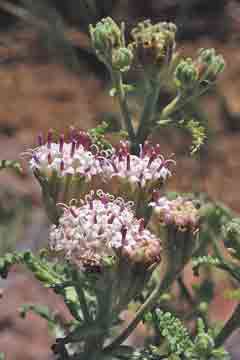 |
Dusty maiden, Chaenactis douglasii
(Hook.) Hook. & Arn. var. douglasii
(left). The generic name Chaenactis was derived
from the Greek chaino meaning “to gape” and aktin
meaning “ray,” for the wide- mouthed flowers on the periphery of
the disk are wide-mouthed. One might not recognize this plant as an Asteraceae,
but the protruding forked styles are a tipoff. The florets are
white to pale pink, their color accentuated by the pink styles. The dusty
maiden grows to fairly high elevations, and blooms—often in great
numbers—on dry slopes. Dull gray-green frilly leaves explain the
common name, “dusty maiden.”
Alpine chaenactis, Chaenactis douglasii (Hook.) Hook. &
Arn. var. alpina A. Gray (right). The alpine
chaenactis is a small perennial that blooms toward summer’s end, nestled
among the rocks of talus slopes near treeline and above. It resembles
a smaller version of Chaenactis douglasii var. douglasii, differing
in its white flowerheads and bare stems. This and the plant on the left are
now classified as a single species, although they differ enough in appearance
that one might believe this is a separate species rather than a
variety. |
 |
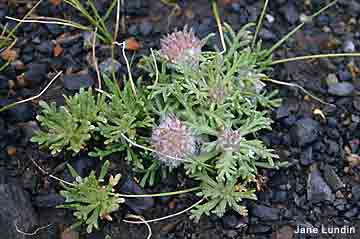 |
Another chaenactis, Evermann's pincushion,
Chaenactis
evermannii Greene
(left), occurs only in Central Idaho as a high
altitude, mat-forming, hairy flowerheads and irregularly pinnate (feather-like)
leaves with blunt-ended leaflets.
Western snakeroot, Ageratina
occidentalis (Hook.)
R. M. King & H. E. Rob. (right). This plant, also known as the western
boneset, was until recently classified as a Eupatorium, a genus that
includes the common joe pye-weeds. Protruding forked styles, a distinguishing
feature of composites in general, give the flowers a feathery appearance.
The western boneset prefers subalpine to alpine cliffs and other rocky
surroundings where it commonly is clustered.. The name Ageratina was
that of a unknown ancient Greek plant, and means “everlasting,”
from the suffix a for “not” and gera for
“old” (for its long-lasting flowers). David Douglas collected this
species on the “Lewis and Clark River” (today’s Snake
River).
|
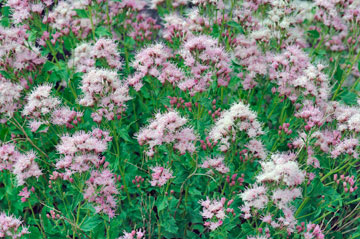 |
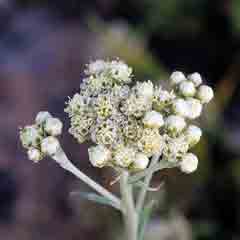 |
Pearly-everlasting (left), Anaphalis
margaritacea (L.) Benth. & Hook.
f. (left). Anaphalis is the ancient Greek name
for a similar plant. The name margaritacea echoes its common name,
meaning “pearly.” Each of its round, white flowerheads has a
characteristic diffuse black dot on the surrounding involucre. The only member
of the genus, it is related to Antennaria and grows in most of North
America. It dries well and can be used in dried flower arrangements. Supposedly
the pearly-everlasting was the first North American herb to be cultivated
in Europe, because of purported medicinal value.
Rosy pussy-toes, Antennaria
rosea
Greene (right). Pussy-toes are not particularly
attractive, but they are so numerous that one cannot help but notice
them—this one especially, for its reddish hue. A rosette of basal leaves
gives off a stem surmounted by a cluster of small flowerheads about the size
of a house-cat’s digital pad, whence their common name. After the
“toes” open one can see that each flowerhead is made up of many
tiny flowers. The name Antennaria was apparently derived from the
resemblance of the flower’s pappus to an insect antenna. |
 |
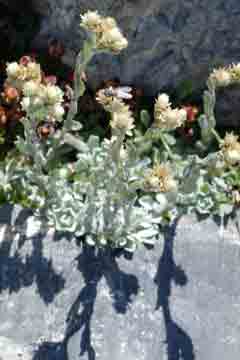 |
Rocky Mountain pussy-toes,
Antennaria media
Greene (left). The Rocky Mountain pussy-toes, shown
here in flower, grows on alpine and arctic tundra in our western mountain
states and provinces, north to Alaska, and south to California, Arizona and
New Mexico. Its tiny oval leaves are covered with fine hairs giving them
a color more gray than green. It is commmonly found on rocky ground where
it is nurtured by the retained heat of the sun.
Hooker's pussy-toes, Antennaria racemosa
Hook. (right) is a rangier plant with open clusters
of small flowerheads and green, rather than the frosted gray-green
foliage of other antennarias that grow in our mountains. It also seems to
be less common. The plants are restricted to our Northwest and the adjacent
southwestern part of Canada. |
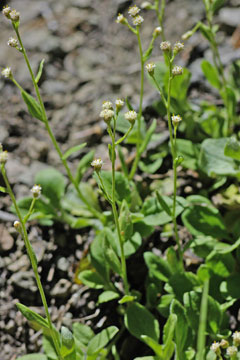 |
 |
Common yarrow, Achillea
millefolium L. The common yarrow (left,
right) is really not a rayless plant, but it appears to be rayless until
one looks closely.You’ll see that each little “flower” has,
in addition to tiny rays, a disk made up of florets (right). The yarrow grows
all over the Northern Hemisphere, from sea level to alpine tundra, blooming
from late spring into the fall. Achilles used the yarrow to treat his companion's
wounds--the derivation of the name. The species name, millefolium,
describes the plant’s finely divided leaves. Lewis and Clark collected
the common yarrrow on May 20, 1806, in today’s north-central
Idaho. |
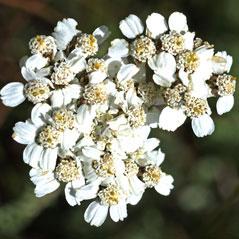 |
 |
The Lousiana, or White Sage, Artemisia
ludoviciana Nutt. var. latiloba
Nutt. shown here in flower (left), is the second most
common Artemisia in our mountains, growing as high as treeline.
Blue-green, divided, spidery leaves and pronounced herbal odor identify the
plant. Early settlers used dried leaves of various artemisias, including
this one, as culinary herbs. Artemisias have also been used medicinally,
but other than possible usefulness in treating intestinal worms, they have
no proven therapeutic value in Western medicine. Recently, however, an extract,
artemisinin, from a Eurasian plant, Artemisia annua, long used in
Chinese medicine, has been shown to be effective in treating
the most virulent form of malaria (Plasmodium falciparum), and may prove
useful as an anti-cancer drug.
Artemisia ludoviciana Nutt. var.
incompta (Nutt.) Cronquist (right), also
in flower, is a true alpine plant; one must climb high to find it. Its leaves
are more divided, less pubescent (covered with fine hair), so the plant is
greener than the common var. latiloba. As with all artemisias, the flowers
tend to be small and unimpressive.
|
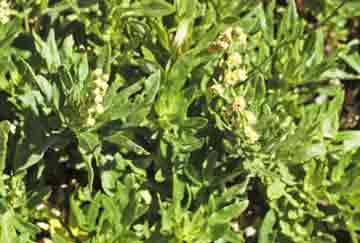 |
 |
Big Sagebrush, Artemisia
tridentata Nutt. subsp. vaseyana (Rydb.)
Beetle (left). The subspecies of big sagebrush that grows
in our mountains is characterized by spike-like inflorescences that stand
above the rest of the plant. It grows as high as alpine tundra. When
sagebrush is in bloom (starting about August 15th, a date well known to allergy
sufferers) look at one of the small flowerheads and you will see that each
is made up of many tiny flowers. Lewis and Clark collected five species of
Artemisia during their journey (cana, dracunculus, frigida, longifolia,
ludoviciana), but for whatever reason omitted the big sagebrush, the
most ubiquitous of all!
Silver sagebrush, Artemisia cana Pursh
(right) is well named. Its silvery, gray-green foliage
makes it quite noticeable. Its identity is confirmed by its straight "entire"
(i.e. , plain, without lobes or serrations) linear leaves. Possibly it is
because of our awareness of climate change, with migration of plants to higher
elevations, but we seem to be finding silver sage growing at higher altitudes
than formerly. |
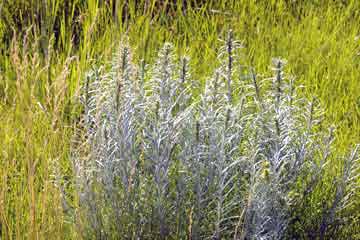 |













